Nursing Case Study: Diabetic Ketoacidosis in Hayley Smith
VerifiedAdded on 2022/10/08
|7
|1635
|29
Case Study
AI Summary
This case study focuses on a patient named Hayley Smith who presents with diabetic ketoacidosis (DKA). The assignment begins with an overview of the patient's initial presentation, including vital signs and symptoms such as a sweet-smelling breath, rapid breathing, and elevated blood glucose le...
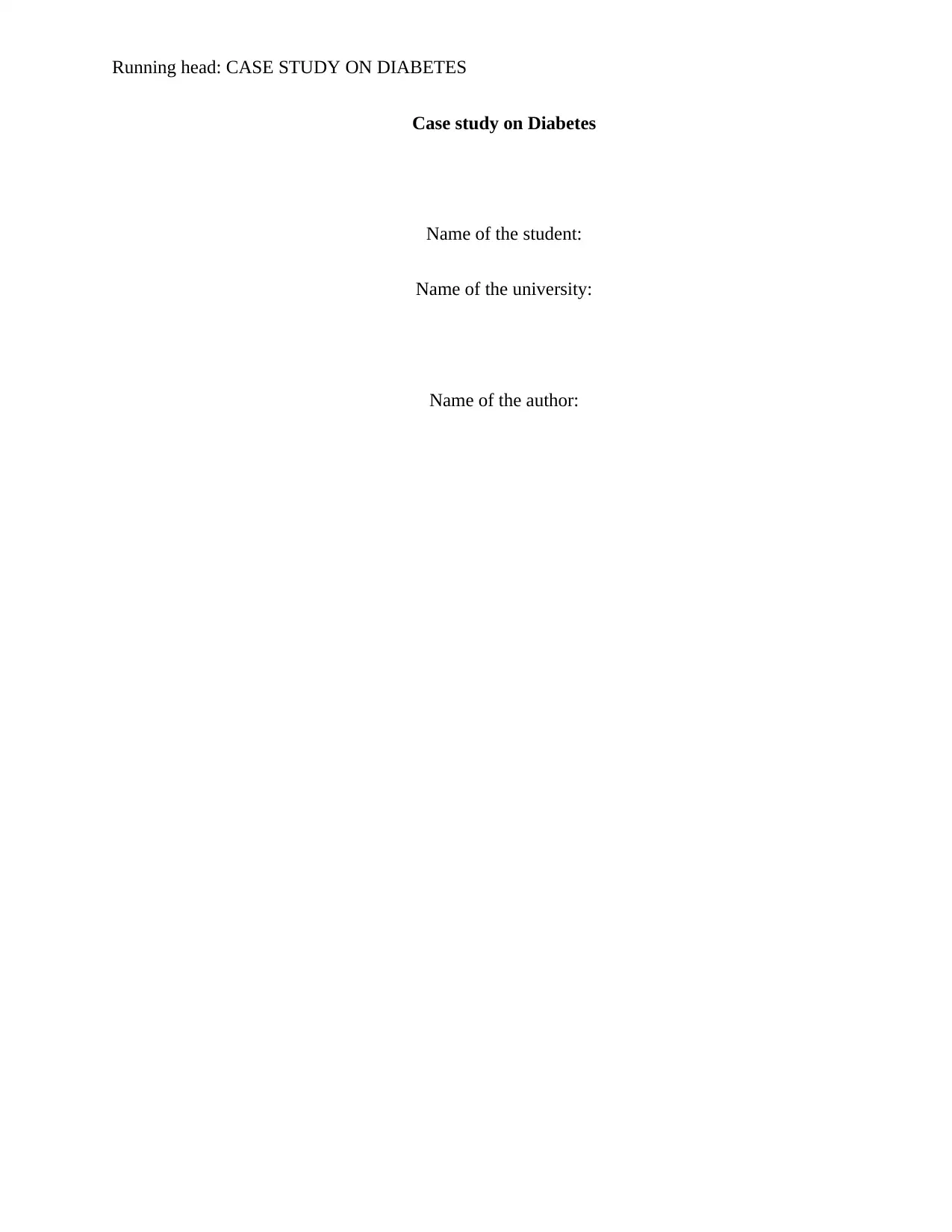
Running head: CASE STUDY ON DIABETES
Case study on Diabetes
Name of the student:
Name of the university:
Name of the author:
Case study on Diabetes
Name of the student:
Name of the university:
Name of the author:
Paraphrase This Document
Need a fresh take? Get an instant paraphrase of this document with our AI Paraphraser
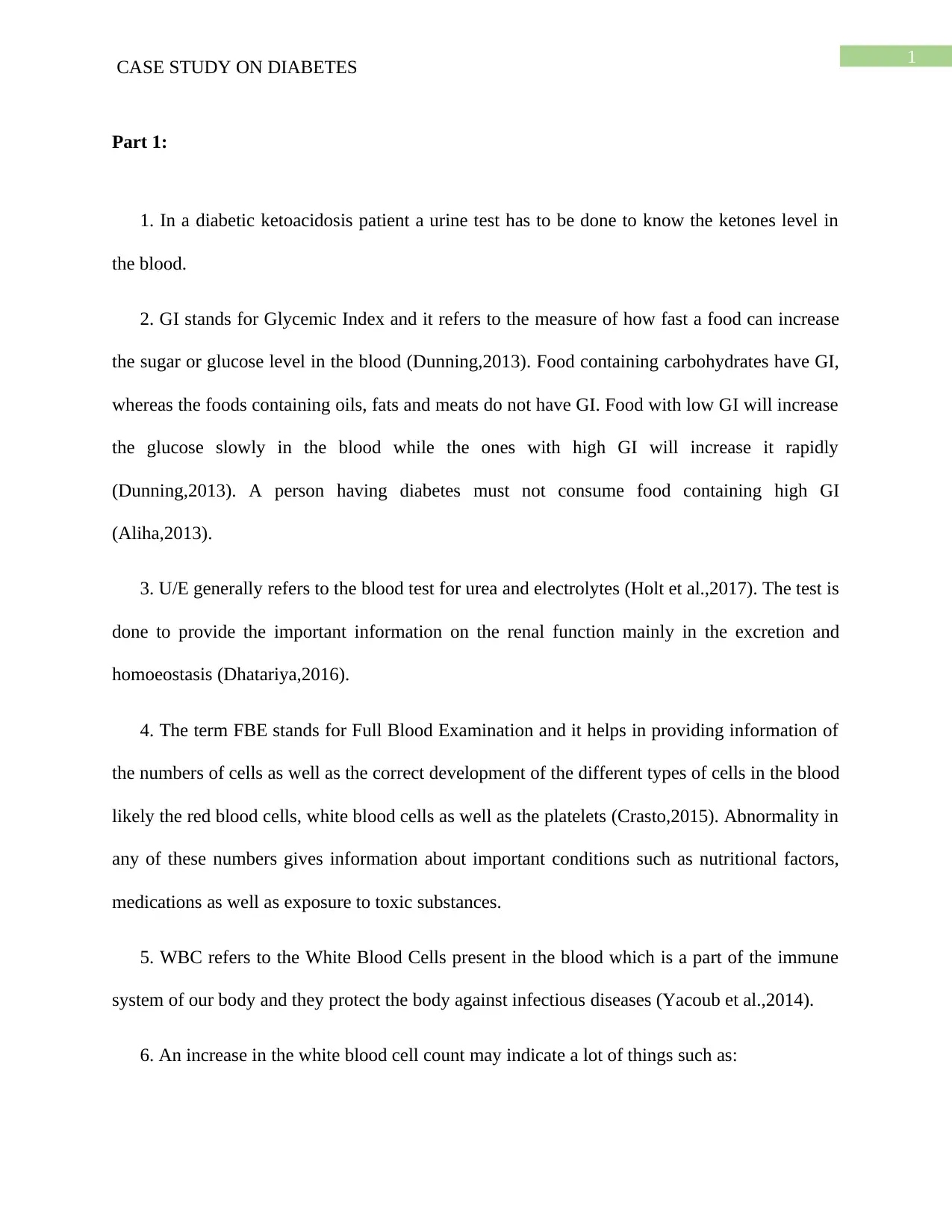
1
CASE STUDY ON DIABETES
Part 1:
1. In a diabetic ketoacidosis patient a urine test has to be done to know the ketones level in
the blood.
2. GI stands for Glycemic Index and it refers to the measure of how fast a food can increase
the sugar or glucose level in the blood (Dunning,2013). Food containing carbohydrates have GI,
whereas the foods containing oils, fats and meats do not have GI. Food with low GI will increase
the glucose slowly in the blood while the ones with high GI will increase it rapidly
(Dunning,2013). A person having diabetes must not consume food containing high GI
(Aliha,2013).
3. U/E generally refers to the blood test for urea and electrolytes (Holt et al.,2017). The test is
done to provide the important information on the renal function mainly in the excretion and
homoeostasis (Dhatariya,2016).
4. The term FBE stands for Full Blood Examination and it helps in providing information of
the numbers of cells as well as the correct development of the different types of cells in the blood
likely the red blood cells, white blood cells as well as the platelets (Crasto,2015). Abnormality in
any of these numbers gives information about important conditions such as nutritional factors,
medications as well as exposure to toxic substances.
5. WBC refers to the White Blood Cells present in the blood which is a part of the immune
system of our body and they protect the body against infectious diseases (Yacoub et al.,2014).
6. An increase in the white blood cell count may indicate a lot of things such as:
CASE STUDY ON DIABETES
Part 1:
1. In a diabetic ketoacidosis patient a urine test has to be done to know the ketones level in
the blood.
2. GI stands for Glycemic Index and it refers to the measure of how fast a food can increase
the sugar or glucose level in the blood (Dunning,2013). Food containing carbohydrates have GI,
whereas the foods containing oils, fats and meats do not have GI. Food with low GI will increase
the glucose slowly in the blood while the ones with high GI will increase it rapidly
(Dunning,2013). A person having diabetes must not consume food containing high GI
(Aliha,2013).
3. U/E generally refers to the blood test for urea and electrolytes (Holt et al.,2017). The test is
done to provide the important information on the renal function mainly in the excretion and
homoeostasis (Dhatariya,2016).
4. The term FBE stands for Full Blood Examination and it helps in providing information of
the numbers of cells as well as the correct development of the different types of cells in the blood
likely the red blood cells, white blood cells as well as the platelets (Crasto,2015). Abnormality in
any of these numbers gives information about important conditions such as nutritional factors,
medications as well as exposure to toxic substances.
5. WBC refers to the White Blood Cells present in the blood which is a part of the immune
system of our body and they protect the body against infectious diseases (Yacoub et al.,2014).
6. An increase in the white blood cell count may indicate a lot of things such as:
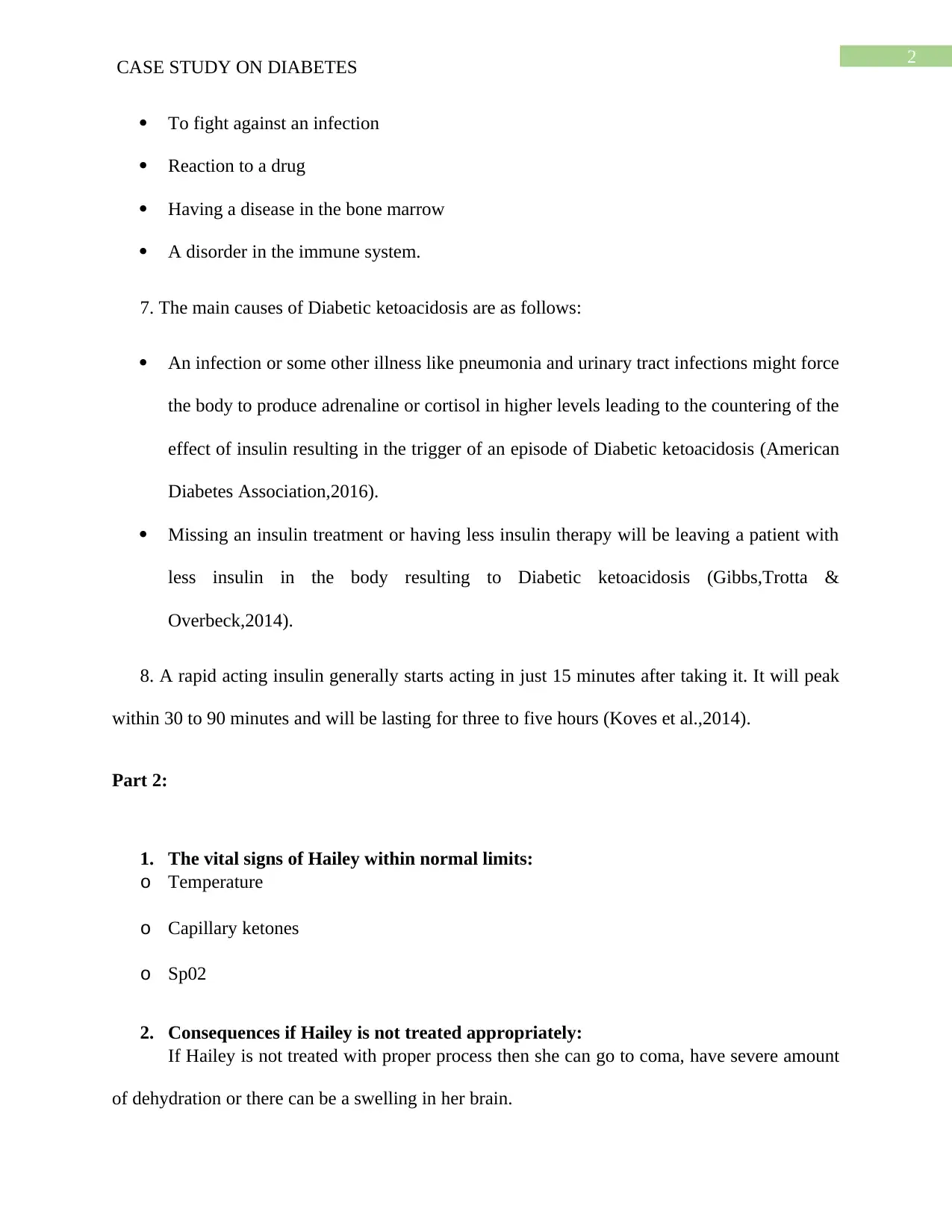
2
CASE STUDY ON DIABETES
To fight against an infection
Reaction to a drug
Having a disease in the bone marrow
A disorder in the immune system.
7. The main causes of Diabetic ketoacidosis are as follows:
An infection or some other illness like pneumonia and urinary tract infections might force
the body to produce adrenaline or cortisol in higher levels leading to the countering of the
effect of insulin resulting in the trigger of an episode of Diabetic ketoacidosis (American
Diabetes Association,2016).
Missing an insulin treatment or having less insulin therapy will be leaving a patient with
less insulin in the body resulting to Diabetic ketoacidosis (Gibbs,Trotta &
Overbeck,2014).
8. A rapid acting insulin generally starts acting in just 15 minutes after taking it. It will peak
within 30 to 90 minutes and will be lasting for three to five hours (Koves et al.,2014).
Part 2:
1. The vital signs of Hailey within normal limits:
o Temperature
o Capillary ketones
o Sp02
2. Consequences if Hailey is not treated appropriately:
If Hailey is not treated with proper process then she can go to coma, have severe amount
of dehydration or there can be a swelling in her brain.
CASE STUDY ON DIABETES
To fight against an infection
Reaction to a drug
Having a disease in the bone marrow
A disorder in the immune system.
7. The main causes of Diabetic ketoacidosis are as follows:
An infection or some other illness like pneumonia and urinary tract infections might force
the body to produce adrenaline or cortisol in higher levels leading to the countering of the
effect of insulin resulting in the trigger of an episode of Diabetic ketoacidosis (American
Diabetes Association,2016).
Missing an insulin treatment or having less insulin therapy will be leaving a patient with
less insulin in the body resulting to Diabetic ketoacidosis (Gibbs,Trotta &
Overbeck,2014).
8. A rapid acting insulin generally starts acting in just 15 minutes after taking it. It will peak
within 30 to 90 minutes and will be lasting for three to five hours (Koves et al.,2014).
Part 2:
1. The vital signs of Hailey within normal limits:
o Temperature
o Capillary ketones
o Sp02
2. Consequences if Hailey is not treated appropriately:
If Hailey is not treated with proper process then she can go to coma, have severe amount
of dehydration or there can be a swelling in her brain.
⊘ This is a preview!⊘
Do you want full access?
Subscribe today to unlock all pages.

Trusted by 1+ million students worldwide

3
CASE STUDY ON DIABETES
3.
Statement True/false
Hayley’s sweet-smelling breath could be related to
something she has eaten
False
Since the breath of a person
suffering from diabetic
ketoacidosis is sweet-smelling
(Ullah et al.,2015).
Hayley’s sleepiness is because she was at a party last night True
A diabetic ketoacidosis patient
finds it harder to fall sleep due
to loss of breath
Hayley’s sweet-smelling breath could be related to ketone
production in the liver True
When the liver releases ketones
it also releases acetone as a by-
product which makes the smell
sweeter (Sibai & Viteri,2014).
Hayley’s tachycardia may mean she has an infection True
This might happen due to the
increased demand in
metabolism
The condition of Hayley’s oral mucosa is related to her fluid
status
True
By looking at the oral mucosa it
can be stated whether a patient
is dehydrated or not
Hayley’s sleepiness is probably due to a head injury – you
should suggest a CT
False
Diabetic ketoacidosis causes
fatigue and weakness in
patients (Wolfsdorf et al.,2014).
Hayley’s rapid respirations have no association with DKA False
Due to the presence of high
levels of ketones in the blood
CASE STUDY ON DIABETES
3.
Statement True/false
Hayley’s sweet-smelling breath could be related to
something she has eaten
False
Since the breath of a person
suffering from diabetic
ketoacidosis is sweet-smelling
(Ullah et al.,2015).
Hayley’s sleepiness is because she was at a party last night True
A diabetic ketoacidosis patient
finds it harder to fall sleep due
to loss of breath
Hayley’s sweet-smelling breath could be related to ketone
production in the liver True
When the liver releases ketones
it also releases acetone as a by-
product which makes the smell
sweeter (Sibai & Viteri,2014).
Hayley’s tachycardia may mean she has an infection True
This might happen due to the
increased demand in
metabolism
The condition of Hayley’s oral mucosa is related to her fluid
status
True
By looking at the oral mucosa it
can be stated whether a patient
is dehydrated or not
Hayley’s sleepiness is probably due to a head injury – you
should suggest a CT
False
Diabetic ketoacidosis causes
fatigue and weakness in
patients (Wolfsdorf et al.,2014).
Hayley’s rapid respirations have no association with DKA False
Due to the presence of high
levels of ketones in the blood
Paraphrase This Document
Need a fresh take? Get an instant paraphrase of this document with our AI Paraphraser
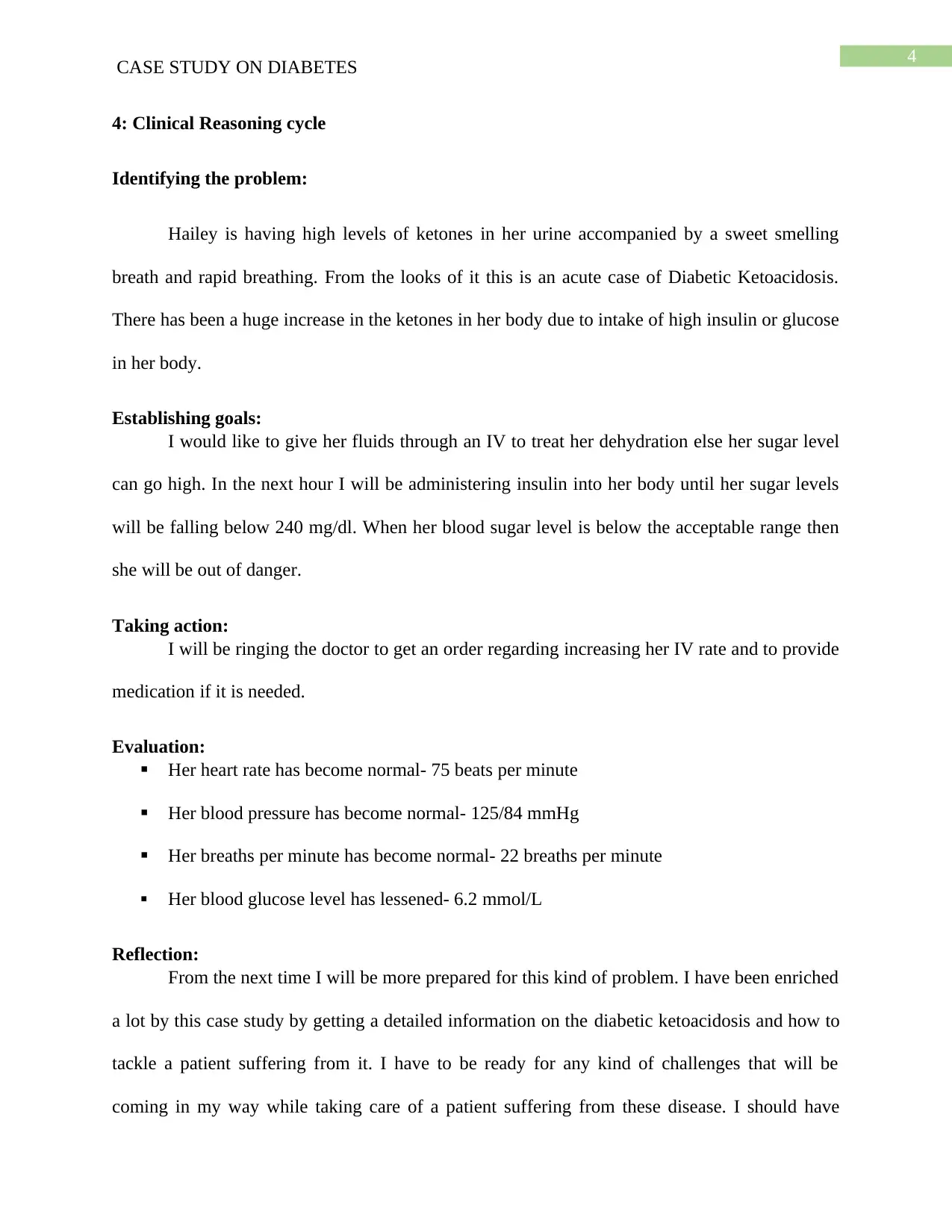
4
CASE STUDY ON DIABETES
4: Clinical Reasoning cycle
Identifying the problem:
Hailey is having high levels of ketones in her urine accompanied by a sweet smelling
breath and rapid breathing. From the looks of it this is an acute case of Diabetic Ketoacidosis.
There has been a huge increase in the ketones in her body due to intake of high insulin or glucose
in her body.
Establishing goals:
I would like to give her fluids through an IV to treat her dehydration else her sugar level
can go high. In the next hour I will be administering insulin into her body until her sugar levels
will be falling below 240 mg/dl. When her blood sugar level is below the acceptable range then
she will be out of danger.
Taking action:
I will be ringing the doctor to get an order regarding increasing her IV rate and to provide
medication if it is needed.
Evaluation:
Her heart rate has become normal- 75 beats per minute
Her blood pressure has become normal- 125/84 mmHg
Her breaths per minute has become normal- 22 breaths per minute
Her blood glucose level has lessened- 6.2 mmol/L
Reflection:
From the next time I will be more prepared for this kind of problem. I have been enriched
a lot by this case study by getting a detailed information on the diabetic ketoacidosis and how to
tackle a patient suffering from it. I have to be ready for any kind of challenges that will be
coming in my way while taking care of a patient suffering from these disease. I should have
CASE STUDY ON DIABETES
4: Clinical Reasoning cycle
Identifying the problem:
Hailey is having high levels of ketones in her urine accompanied by a sweet smelling
breath and rapid breathing. From the looks of it this is an acute case of Diabetic Ketoacidosis.
There has been a huge increase in the ketones in her body due to intake of high insulin or glucose
in her body.
Establishing goals:
I would like to give her fluids through an IV to treat her dehydration else her sugar level
can go high. In the next hour I will be administering insulin into her body until her sugar levels
will be falling below 240 mg/dl. When her blood sugar level is below the acceptable range then
she will be out of danger.
Taking action:
I will be ringing the doctor to get an order regarding increasing her IV rate and to provide
medication if it is needed.
Evaluation:
Her heart rate has become normal- 75 beats per minute
Her blood pressure has become normal- 125/84 mmHg
Her breaths per minute has become normal- 22 breaths per minute
Her blood glucose level has lessened- 6.2 mmol/L
Reflection:
From the next time I will be more prepared for this kind of problem. I have been enriched
a lot by this case study by getting a detailed information on the diabetic ketoacidosis and how to
tackle a patient suffering from it. I have to be ready for any kind of challenges that will be
coming in my way while taking care of a patient suffering from these disease. I should have

5
CASE STUDY ON DIABETES
made a thorough research on this disease before going for the case study. I now understand what
the proper ways are for taking care of a diabetic ketoacidosis patient and the step by step process
of it.
Reference List
Aliha, J. M., Asgari, M., Khayeri, F., Ramazani, M., Farajzadegan, Z., & Javaheri, J. (2013).
Group education and nurse-telephone follow-up effects on blood glucose control and
adherence to treatment in type 2 diabetes patients. International journal of preventive
medicine, 4(7), 797.
American Diabetes Association. (2016). 13. Diabetes care in the hospital. Diabetes Care,
39(Supplement 1), S99-S104.
Crasto, W., Htike, Z. Z., Turner, L., & Higgins, K. (2015). Management of diabetic ketoacidosis
following implementation of the JBDS guidelines: Where are we and where should we
go?. British Journal of Diabetes, 15(1), 11-16.
Dhatariya, K. K., Nunney, I., Higgins, K., Sampson, M. J., & Iceton, G. (2016). National survey
of the management of diabetic ketoacidosis (DKA) in the UK in 2014. Diabetic
Medicine, 33(2), 252-260.
Dunning, T. (2013). Care of people with diabetes: a manual of nursing practice. John Wiley &
Sons.
Gibbs, J., Trotta, D., & Overbeck, A. (2014). Human patient simulation versus case study:
Which teaching strategy is more effective in teaching nursing care for the hypoglycemic
patient?. Teaching and Learning in Nursing, 9(2), 59-63.
CASE STUDY ON DIABETES
made a thorough research on this disease before going for the case study. I now understand what
the proper ways are for taking care of a diabetic ketoacidosis patient and the step by step process
of it.
Reference List
Aliha, J. M., Asgari, M., Khayeri, F., Ramazani, M., Farajzadegan, Z., & Javaheri, J. (2013).
Group education and nurse-telephone follow-up effects on blood glucose control and
adherence to treatment in type 2 diabetes patients. International journal of preventive
medicine, 4(7), 797.
American Diabetes Association. (2016). 13. Diabetes care in the hospital. Diabetes Care,
39(Supplement 1), S99-S104.
Crasto, W., Htike, Z. Z., Turner, L., & Higgins, K. (2015). Management of diabetic ketoacidosis
following implementation of the JBDS guidelines: Where are we and where should we
go?. British Journal of Diabetes, 15(1), 11-16.
Dhatariya, K. K., Nunney, I., Higgins, K., Sampson, M. J., & Iceton, G. (2016). National survey
of the management of diabetic ketoacidosis (DKA) in the UK in 2014. Diabetic
Medicine, 33(2), 252-260.
Dunning, T. (2013). Care of people with diabetes: a manual of nursing practice. John Wiley &
Sons.
Gibbs, J., Trotta, D., & Overbeck, A. (2014). Human patient simulation versus case study:
Which teaching strategy is more effective in teaching nursing care for the hypoglycemic
patient?. Teaching and Learning in Nursing, 9(2), 59-63.
⊘ This is a preview!⊘
Do you want full access?
Subscribe today to unlock all pages.

Trusted by 1+ million students worldwide
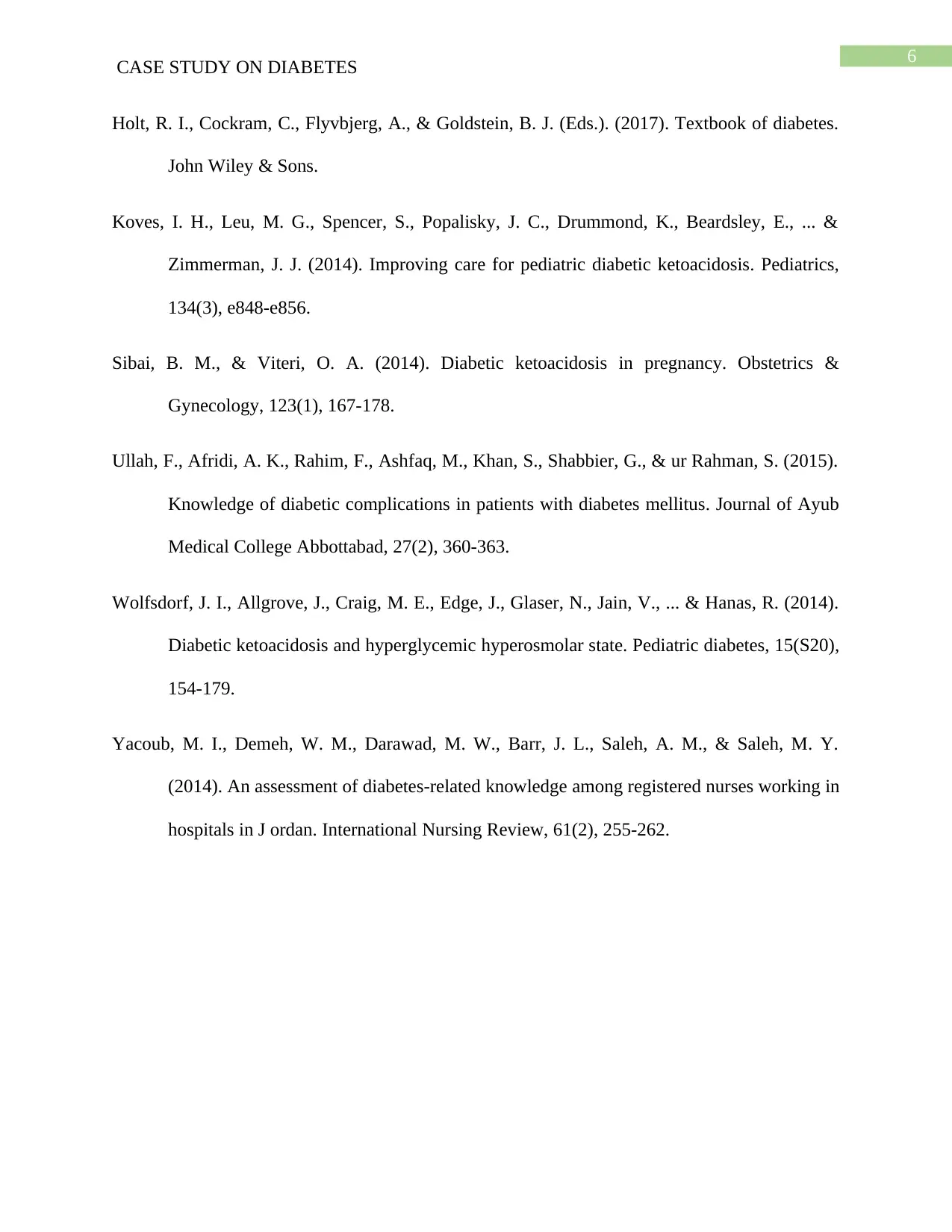
6
CASE STUDY ON DIABETES
Holt, R. I., Cockram, C., Flyvbjerg, A., & Goldstein, B. J. (Eds.). (2017). Textbook of diabetes.
John Wiley & Sons.
Koves, I. H., Leu, M. G., Spencer, S., Popalisky, J. C., Drummond, K., Beardsley, E., ... &
Zimmerman, J. J. (2014). Improving care for pediatric diabetic ketoacidosis. Pediatrics,
134(3), e848-e856.
Sibai, B. M., & Viteri, O. A. (2014). Diabetic ketoacidosis in pregnancy. Obstetrics &
Gynecology, 123(1), 167-178.
Ullah, F., Afridi, A. K., Rahim, F., Ashfaq, M., Khan, S., Shabbier, G., & ur Rahman, S. (2015).
Knowledge of diabetic complications in patients with diabetes mellitus. Journal of Ayub
Medical College Abbottabad, 27(2), 360-363.
Wolfsdorf, J. I., Allgrove, J., Craig, M. E., Edge, J., Glaser, N., Jain, V., ... & Hanas, R. (2014).
Diabetic ketoacidosis and hyperglycemic hyperosmolar state. Pediatric diabetes, 15(S20),
154-179.
Yacoub, M. I., Demeh, W. M., Darawad, M. W., Barr, J. L., Saleh, A. M., & Saleh, M. Y.
(2014). An assessment of diabetes‐related knowledge among registered nurses working in
hospitals in J ordan. International Nursing Review, 61(2), 255-262.
CASE STUDY ON DIABETES
Holt, R. I., Cockram, C., Flyvbjerg, A., & Goldstein, B. J. (Eds.). (2017). Textbook of diabetes.
John Wiley & Sons.
Koves, I. H., Leu, M. G., Spencer, S., Popalisky, J. C., Drummond, K., Beardsley, E., ... &
Zimmerman, J. J. (2014). Improving care for pediatric diabetic ketoacidosis. Pediatrics,
134(3), e848-e856.
Sibai, B. M., & Viteri, O. A. (2014). Diabetic ketoacidosis in pregnancy. Obstetrics &
Gynecology, 123(1), 167-178.
Ullah, F., Afridi, A. K., Rahim, F., Ashfaq, M., Khan, S., Shabbier, G., & ur Rahman, S. (2015).
Knowledge of diabetic complications in patients with diabetes mellitus. Journal of Ayub
Medical College Abbottabad, 27(2), 360-363.
Wolfsdorf, J. I., Allgrove, J., Craig, M. E., Edge, J., Glaser, N., Jain, V., ... & Hanas, R. (2014).
Diabetic ketoacidosis and hyperglycemic hyperosmolar state. Pediatric diabetes, 15(S20),
154-179.
Yacoub, M. I., Demeh, W. M., Darawad, M. W., Barr, J. L., Saleh, A. M., & Saleh, M. Y.
(2014). An assessment of diabetes‐related knowledge among registered nurses working in
hospitals in J ordan. International Nursing Review, 61(2), 255-262.
1 out of 7
Related Documents
Your All-in-One AI-Powered Toolkit for Academic Success.
+13062052269
info@desklib.com
Available 24*7 on WhatsApp / Email
![[object Object]](/_next/static/media/star-bottom.7253800d.svg)
Unlock your academic potential
© 2024 | Zucol Services PVT LTD | All rights reserved.





